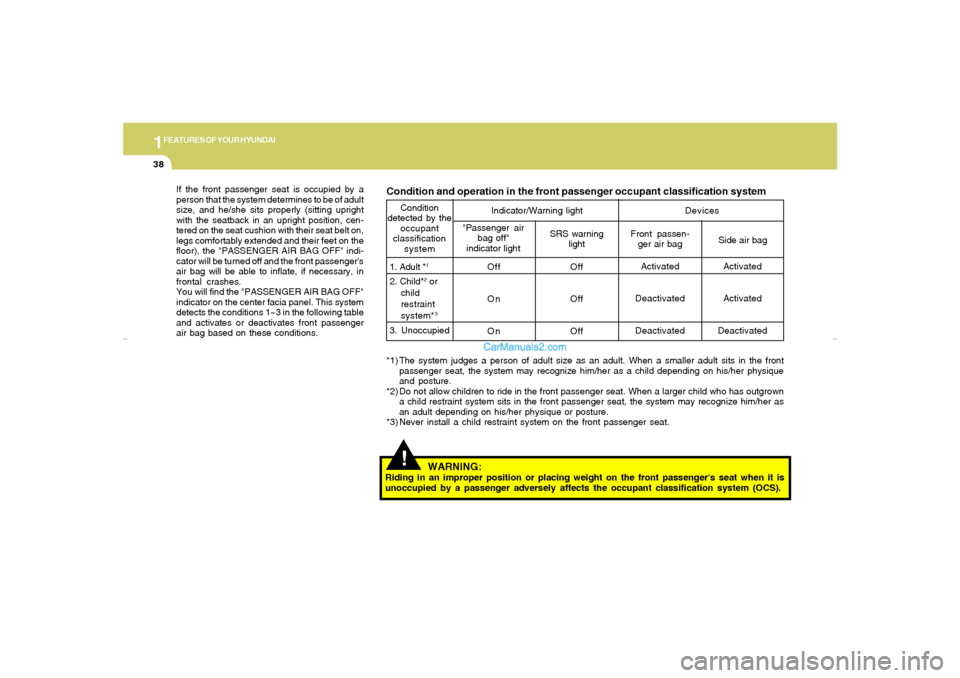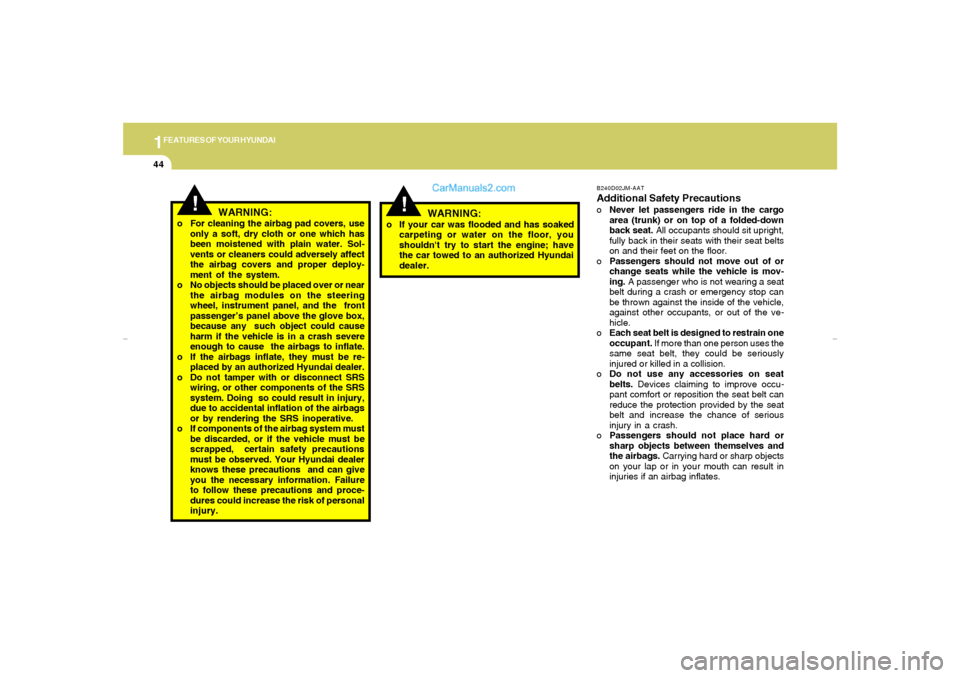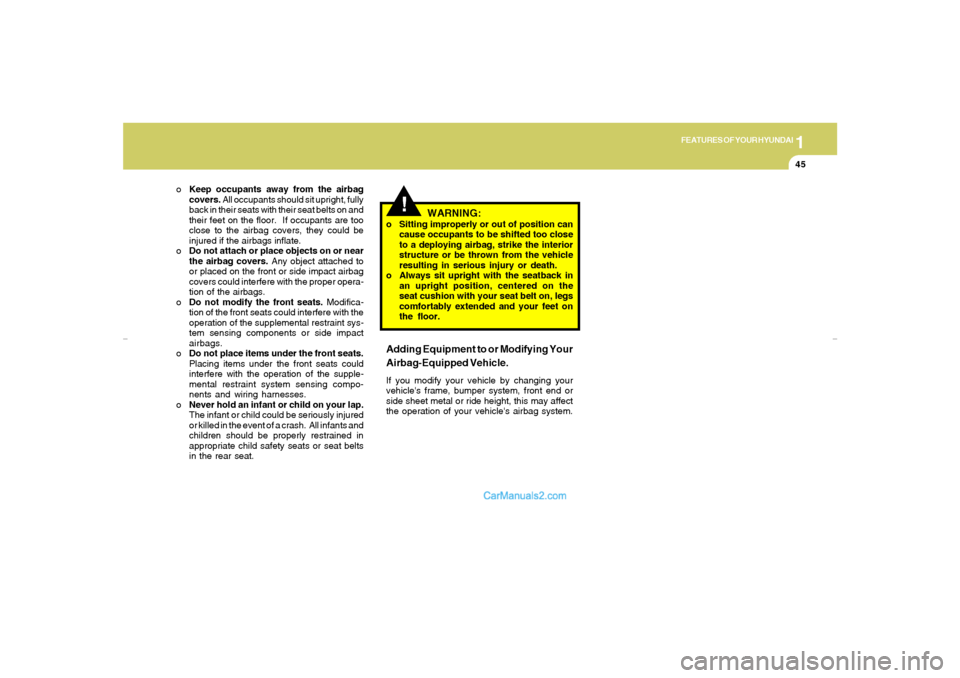2007 Hyundai Tiburon belt
[x] Cancel search: beltPage 48 of 269

1FEATURES OF YOUR HYUNDAI36
Passanger's Airbag
OGK016241
!
CAUTION:
Do not install or place any accessories
(drink holder, cassette holder, sticker, etc)
on the front passenger's panel above the
glove box in a vehicle with a passenger's air
bag. Such objects may become dangerous
projectiles and cause injury if the
passenger's air bag inflates.
Upon deployment, tear seams molded directly
into the pad covers will separate under pres-
sure from the expansion of the airbags. Further
opening of the covers then allows full inflation of
the airbags. The airbag modules are located both in the
center of the steering wheel and in the front
passenger's panel above the glove box. When
the SRSCM detects a sufficiently severe impact
to the front of the vehicle, it will automatically
deploy the front airbags.
B240B02L
A fully inflated airbag, in combination with a
properly worn seat belt, slows the driver's or the
passenger's forward motion, reducing the risk
of head and chest injury.
After complete inflation, the airbag immediately
starts deflating, enabling the driver to maintain
forward visibility and the ability to steer or
operate other controls.
B240B03L
gkflhma-1a.p659/12/2006, 3:16 PM 36
Page 50 of 269

1FEATURES OF YOUR HYUNDAI38
If the front passenger seat is occupied by a
person that the system determines to be of adult
size, and he/she sits properly (sitting upright
with the seatback in an upright position, cen-
tered on the seat cushion with their seat belt on,
legs comfortably extended and their feet on the
floor), the "PASSENGER AIR BAG OFF" indi-
cator will be turned off and the front passenger's
air bag will be able to inflate, if necessary, in
frontal crashes.
You will find the "PASSENGER AIR BAG OFF"
indicator on the center facia panel. This system
detects the conditions 1~3 in the following table
and activates or deactivates front passenger
air bag based on these conditions.
Condition and operation in the front passenger occupant classification system
Condition
detected by the
occupant
classification
system
"Passenger air
bag off"
indicator lightSRS warning
lightFront passen-
ger air bagSide air bag
Indicator/Warning lightDevices
1. Adult *
1
2. Child*
2 or
child
restraint
system*3
3. UnoccupiedOff
On
OnOff
Off
OffActivated
Deactivated
DeactivatedActivated
Activated
Deactivated*1) The system judges a person of adult size as an adult. When a smaller adult sits in the front
passenger seat, the system may recognize him/her as a child depending on his/her physique
and posture.
*2) Do not allow children to ride in the front passenger seat. When a larger child who has outgrown
a child restraint system sits in the front passenger seat, the system may recognize him/her as
an adult depending on his/her physique or posture.
*3) Never install a child restraint system on the front passenger seat.
!
WARNING:
Riding in an improper position or placing weight on the front passenger's seat when it is
unoccupied by a passenger adversely affects the occupant classification system (OCS).
gkflhma-1a.p659/12/2006, 3:16 PM 38
Page 52 of 269

1FEATURES OF YOUR HYUNDAI40
When an adult is seated in the front passenger
seat, if the "PASSENGER AIR BAG OFF" indi-
cator is on, turn the ignition key to "LOCK" and
ask the passenger to sit properly (sitting upright
with the seat back in an upright position, centered
on the seat cushion with their seat belt on, legs
comfortably extended and their feet on the floor).
Restart the engine and have the person remain
in that position. This will allow the system to detect
the person and to enable the passenger air bag.
Proper position
B990A01O
If the "PASSENGER AIR BAG OFF" indicator is
still on, ask the passenger to move to the rear
seat.
!
WARNING:
Do not allow an adult to ride in the front seat
when the “PASSENGER AIR BAG OFF”
indicator is illuminated, because the air bag
will not deploy in the event of a crash. If the
"PASSENGER AIR BAG OFF" indicator re-
mains illuminated after the passenger re-
positions themselves properly and the car
is restarted, we recommend that passenger
move to the rear seat because the
passenger's front air bag will not deploy.
Front seat passengers must stay properly
seated to avoid serious injury from a de-
ploying air bag.
NOTE:The "PASSENGER AIR BAG OFF" indicator
illuminates for about 4 seconds after the
ignition key is turned to the "ON" position
or after the engine is started. If the front
passenger seat is occupied, the occupant
classification sensor will then classify the
front passenger after several more sec-
onds.
!
WARNING:
Do not put a heavy load in the front passen-
ger seatback pocket or on the front passen-
ger seat. Do not hang onto the front pas-
senger seat. Do not hang any items such as
a seatback table on the front passenger
seatback. Do not place feet on the front
passenger seatback. Do not place any items
under the front passenger seat. Any of
these could interfere with proper sensor
operation.
gkflhma-1a.p659/12/2006, 3:16 PM 40
Page 53 of 269

1
FEATURES OF YOUR HYUNDAI
41
!
!
CAUTION:
If the occupant classification system is not
working properly, the SRS air bag warning
light
on the instrument panel will illumi-
nate because the passenger's front air bag
is connected with the occupant classifica-
tion system. If there is a malfunction of the
occupant classification system, the "PAS-
SENGER AIR BAG OFF" indicator will illu-
minate and the passenger's front air bag
will not inflate in frontal impact crashes
even if there is adult occupant in the front
passenger's seat. If the SRS air bag warning
light does not illuminate when the ignition
key is turned to the "ON" position, remains
illuminated after approximately 6 seconds
when the ignition key is turned to the "ON"
position, or if it illuminates while the vehicle
is being driven, have an authorized Hyundai
dealer inspect the occupant classification
system and the SRS air bag system as soon
as possible.
!
WARNING:
o Even though your vehicle is equipped
with the occupant classification sys-
tem, never install a child restraint system
in the front passenger's seat. A deploy-
ing air bag can forcefully strike a child
resulting in serious injuries or death.
Any child under 13 years of age should
ride in the rear seat. Children too large
for child restraints should use the avail-
able lap/shoulder belts. No matter what
type of crash, children of all ages are
safer when restrained in the rear seat.
o If the "PASSENGER AIR BAG OFF" indi-
cator is illuminated when the front
passenger's seat is occupied by an adult
and he/she sits properly (sitting upright
with the seatback in an upright position,
centered on the seat cushion with their
seat belt on, legs comfortably extended
and their feet on the floor), have that
person sit in the rear seat.
o Do not modify or replace the front pas-
senger seat. Don't place anything on or
attach anything such as a blanket or
after market seat heater to the front
passenger seat. This can adversely af-
fect the occupant classification system.o Do not sit on sharp objects such as tools
when occupying the front passenger
seat. This can adversely affect the occu-
pant classification system.
o Do not use accessory seat covers on the
front seats.
o Accident statistics show that children
are safer if they are restrained in the rear,
as opposed to the front seat. It is recom-
mended that child restraints be secured
in a rear seat, including an infant riding
in a rear-facing infant seat, a child riding
in a forward-facing child seat and an
older child riding in a booster seat.
o Air bags can only be used once – have an
authorized Hyundai dealer replace the
air bag immediately after deployment.
o A smaller-stature adult who is not seated
correctly (for example: seat excessively
reclined, leaning on the center console,
or hips shifted forward in the seat) can
cause a condition where the advanced
frontal air bag system senses less seated
pressure than if the occupant were
seated properly (sitting upright with the
seatback in an upright position, cen-
tered on the seat cushion with their seat
belt on, legs comfortably extended and
their feet on the floor).
WARNING:
gkflhma-1a.p659/12/2006, 3:16 PM 41
Page 54 of 269

1FEATURES OF YOUR HYUNDAI42
!
WARNING:
!
WARNING:
o The side impact airbag is supplemental
to the driver's and the passenger's seat
belt systems and is not a substitute for
them. Therefore your seat belts must be
worn at all times while the vehicle is in
motion. The airbags deploy only in cer-
tain side impact conditions.
o For best protection from the side impact
airbag system and to avoid being injured
by the deploying side impact airbag,
both front seat occupants should sit in
an upright position with the seat belt
properly fastened. The driver's hands
should be placed on the steering wheel
at the 9:00 and 3:00 o'clock positions.
The passenger's arms and hands should
be placed on their laps.
o Do not use any accessory seat covers.
o Use of seat covers could prevent or
reduce the effectiveness of the system.
B990B02MC-AATSide Impact AirbagYour Hyundai is equipped with a side impact
airbag in each front seat. The purpose of the
airbag is to provide the vehicle's driver and/or
the front passenger with additional protection
than that offered by the seat belt alone. The side
impact airbags are designed to deploy only
during certain side-impact collisions, depend-
ing on the crash severity, angle, speed and point
of impact. The side impact airbags are not
designed to deploy in all side impact situations.
B990B02Y
This condition can result in an adult
potentially being misclassified and illu-
mination of the "PASSENGER AIR BAG
OFF" indicator.
Important Safety Notes on the Side Im-
pact Airbag SystemFollowing is a number of safety points concern-
ing this system which should always be ob-
served to ensure risk of injury is reduced in an
accident.
gkflhma-1a.p659/12/2006, 3:16 PM 42
Page 56 of 269

1FEATURES OF YOUR HYUNDAI44
B240D02JM-AATAdditional Safety PrecautionsoNever let passengers ride in the cargo
area (trunk) or on top of a folded-down
back seat. All occupants should sit upright,
fully back in their seats with their seat belts
on and their feet on the floor.
oPassengers should not move out of or
change seats while the vehicle is mov-
ing. A passenger who is not wearing a seat
belt during a crash or emergency stop can
be thrown against the inside of the vehicle,
against other occupants, or out of the ve-
hicle.
oEach seat belt is designed to restrain one
occupant. If more than one person uses the
same seat belt, they could be seriously
injured or killed in a collision.
oDo not use any accessories on seat
belts. Devices claiming to improve occu-
pant comfort or reposition the seat belt can
reduce the protection provided by the seat
belt and increase the chance of serious
injury in a crash.
oPassengers should not place hard or
sharp objects between themselves and
the airbags. Carrying hard or sharp objects
on your lap or in your mouth can result in
injuries if an airbag inflates.
!
o If your car was flooded and has soaked
carpeting or water on the floor, you
shouldn't try to start the engine; have
the car towed to an authorized Hyundai
dealer.
WARNING:
!
o For cleaning the airbag pad covers, use
only a soft, dry cloth or one which has
been moistened with plain water. Sol-
vents or cleaners could adversely affect
the airbag covers and proper deploy-
ment of the system.
o No objects should be placed over or near
the airbag modules on the steering
wheel, instrument panel, and the front
passenger’s panel above the glove box,
because any such object could cause
harm if the vehicle is in a crash severe
enough to cause the airbags to inflate.
o If the airbags inflate, they must be re-
placed by an authorized Hyundai dealer.
o Do not tamper with or disconnect SRS
wiring, or other components of the SRS
system. Doing so could result in injury,
due to accidental inflation of the airbags
or by rendering the SRS inoperative.
o If components of the airbag system must
be discarded, or if the vehicle must be
scrapped, certain safety precautions
must be observed. Your Hyundai dealer
knows these precautions and can give
you the necessary information. Failure
to follow these precautions and proce-
dures could increase the risk of personal
injury.
WARNING:
gkflhma-1a.p659/12/2006, 3:16 PM 44
Page 57 of 269

1
FEATURES OF YOUR HYUNDAI
45
oKeep occupants away from the airbag
covers. All occupants should sit upright, fully
back in their seats with their seat belts on and
their feet on the floor. If occupants are too
close to the airbag covers, they could be
injured if the airbags inflate.
oDo not attach or place objects on or near
the airbag covers. Any object attached to
or placed on the front or side impact airbag
covers could interfere with the proper opera-
tion of the airbags.
oDo not modify the front seats. Modifica-
tion of the front seats could interfere with the
operation of the supplemental restraint sys-
tem sensing components or side impact
airbags.
oDo not place items under the front seats.
Placing items under the front seats could
interfere with the operation of the supple-
mental restraint system sensing compo-
nents and wiring harnesses.
oNever hold an infant or child on your lap.
The infant or child could be seriously injured
or killed in the event of a crash. All infants and
children should be properly restrained in
appropriate child safety seats or seat belts
in the rear seat.
WARNING:
o Sitting improperly or out of position can
cause occupants to be shifted too close
to a deploying airbag, strike the interior
structure or be thrown from the vehicle
resulting in serious injury or death.
o Always sit upright with the seatback in
an upright position, centered on the
seat cushion with your seat belt on, legs
comfortably extended and your feet on
the floor.Adding Equipment to or Modifying Your
Airbag-Equipped Vehicle.If you modify your vehicle by changing your
vehicle's frame, bumper system, front end or
side sheet metal or ride height, this may affect
the operation of your vehicle's airbag system.
!
gkflhma-1a.p659/12/2006, 3:16 PM 45
Page 59 of 269

1
FEATURES OF YOUR HYUNDAI
47
1. Speedometer
2. Turn Signal Indicator Light
3. Odometer/Trip Odometer
4. Automatic Transaxle Position Indicator Light (If installed)
5. Coolant Temperature Gauge
6. Trip Computer (if installed)
7. Fuel Gauge
8. Tachometer
9. Electronic Stability Control (ESC) Indicator Light (If installed)
10. Low Tire Pressure Telltale
11. TPMS (Tire Pressure Monitoring System) Malfunction Indicator
12. Trip Odometer Reset Knob
13. Charging System Warning Light14. SRS (AIRBAG) Warning Light
15. Seat Belt Warning Light
16. High Beam Indicator Light
17. Low Oil Pressure Warning Light
18. Malfunction Indicator Light (MIL)
19. Low Fuel Warning Light
20. Parking Brake/Low Brake Fluid Level Warning Light
21. Trip Computer Reset Knob (If installed)
22. CRUISE Indicator Light (If installed)
23. CRUISE SET Indicator Light (If installed)
24. Tail Gate Open Warning Light
25. Door Ajar Warning Light
26. ABS Service Reminder Indicator (SRI)
gkflhma-1a.p659/12/2006, 3:16 PM 47